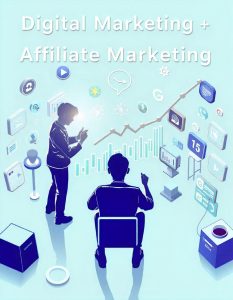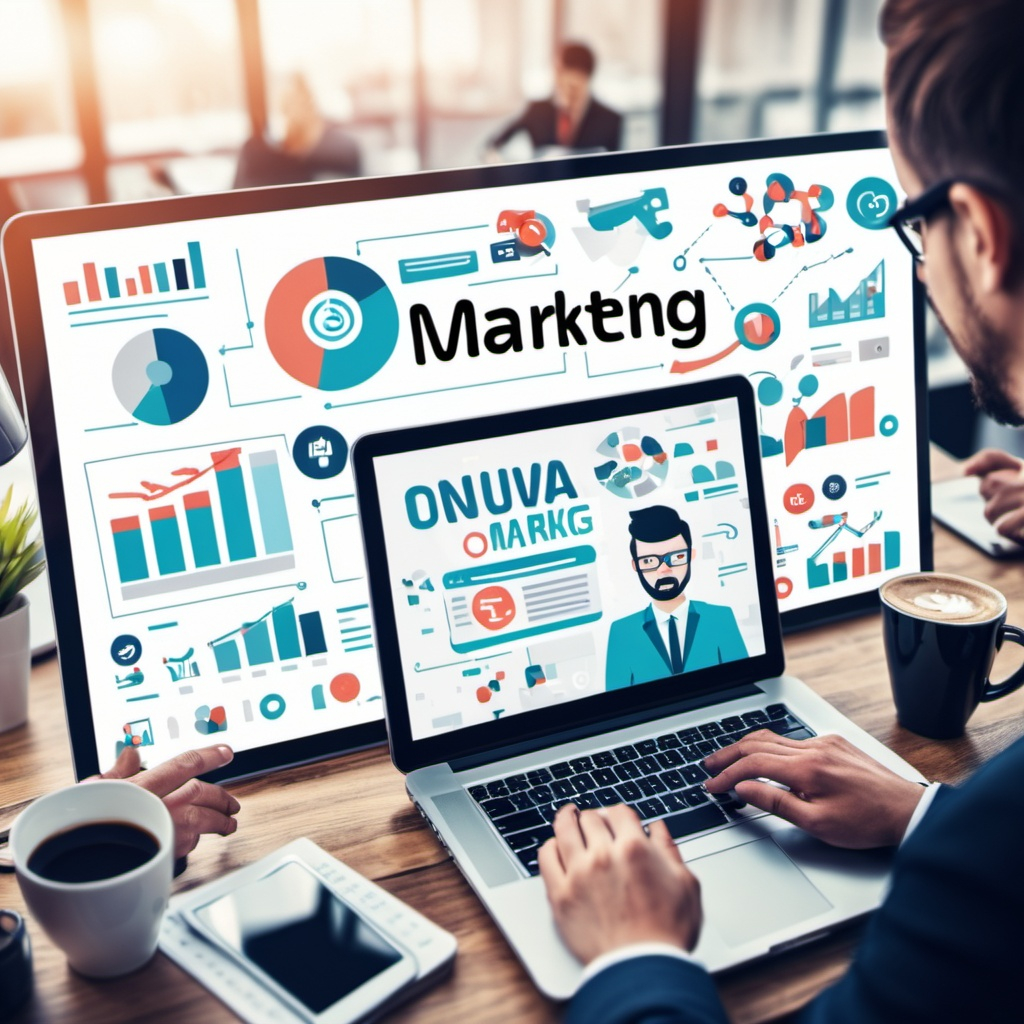Digital Marketing and Affiliate Marketing
In the evolving world of online business, digital marketing and affiliate marketing are two key strategies that can drive growth, enhance brand visibility, and increase revenue. While these two concepts are related, they serve different roles in the marketing ecosystem. In this blog post, we’ll break down the differences, synergies, and benefits of digital marketing and affiliate marketing and explore how businesses and individuals can leverage both for success.
What is Digital Marketing?
Digital marketing refers to all marketing efforts that use digital channels to promote products or services. It encompasses a wide range of online marketing tactics that help businesses reach their target audience through platforms such as search engines, websites, social media, email, and mobile apps.
Some common components of digital marketing include:
- Search Engine Optimization (SEO): Improving a website’s visibility in search engines through organic search results.
- Pay-Per-Click Advertising (PPC): Running ads on platforms like Google Ads or social media sites where advertisers pay for each click.
- Content Marketing: Creating and sharing valuable content to engage, educate, and attract a target audience.
- Social Media Marketing: Using platforms like Facebook, Instagram, Twitter, and LinkedIn to connect with and market to customers.
- Email Marketing: Sending targeted email campaigns to nurture leads and convert them into customers.
Digital marketing is essential for modern businesses because it allows them to connect with customers at various points in their buying journey, providing the opportunity to build relationships, and trust, and ultimately increase sales.
What is Affiliate Marketing?
Affiliate marketing is a performance-based form of digital marketing where businesses partner with affiliates (individuals or other companies) to promote their products or services. In this model, affiliates earn a commission for every sale, lead, or action they generate for the business through their unique referral links.
Affiliate marketing typically involves three parties:
- Advertiser (Merchant): The business offering the product or service.
- Affiliate (Publisher): The individual or company that promotes the product in exchange for a commission.
- Customer: The consumer who purchases the product or service through the affiliate’s referral link.
The affiliate earns revenue by promoting the advertiser’s products through blog posts, social media content, email newsletters, or even paid advertising campaigns. When someone clicks on the affiliate’s link and completes a desired action (such as making a purchase), the affiliate receives a percentage of the sale.
Key Differences Between Digital Marketing and Affiliate Marketing
Though both digital and affiliate marketing are conducted online, they serve different purposes within the marketing ecosystem.
- Digital Marketing: A broad field that encompasses various online marketing strategies such as SEO, content marketing, and PPC. The goal of digital marketing is to generate leads, build brand awareness, and drive sales through online channels.
- Affiliate Marketing: A subset of digital marketing focused on performance-based partnerships. The goal is to generate sales through third-party affiliates who promote the product or service in exchange for a commission.
The core difference lies in the approach. Digital marketing requires direct efforts from the business to attract and convert customers, while affiliate marketing outsources part of the marketing effort to affiliates who work on behalf of the business.

How Digital Marketing and Affiliate Marketing Complement Each Other
Although they are distinct, digital marketing and affiliate marketing can work together to form a powerful marketing strategy. Here are some ways in which they complement each other:
1. Affiliate Marketing as a Subset of Digital Marketing
Affiliate marketing can be seen as one tactic within a larger digital marketing strategy. By incorporating affiliate marketing, a business can expand its reach by leveraging the audiences of various affiliates. This helps the business increase sales without relying solely on its internal marketing efforts.
2. Increased Reach and Traffic
Through affiliate marketing, businesses can reach new audiences that may have been difficult to engage with through their traditional digital marketing channels. Affiliates often have established followings, whether it’s a blog audience, social media followers, or email subscribers. These trusted relationships allow affiliates to introduce products to new customers, driving traffic and potential conversions.
3. Cost-Effectiveness
One of the most attractive aspects of affiliate marketing is its cost-effectiveness. Unlike many other digital marketing techniques (e.g., PPC), where businesses pay upfront costs for visibility, affiliate marketing operates on a pay-for-performance model. Businesses only pay affiliates after a sale or lead is completed, which results in a high return on investment (ROI).
4. Content Creation and SEO
Affiliate marketing also feeds into content marketing and SEO strategies. Affiliates often create valuable content, such as product reviews, blogs, and videos, which help build backlinks to the advertiser’s site. These backlinks not only generate traffic but can improve the advertiser’s search engine rankings, boosting the entire SEO strategy.
5. Trust and Social Proof
Consumers today rely heavily on social proof and recommendations from trusted sources when making purchasing decisions. Affiliates, especially influencers or niche content creators, can provide that trust through authentic product reviews or recommendations. This adds credibility to the brand and can lead to higher conversion rates.
Benefits of Digital Marketing
- Wider Audience Reach: Digital marketing allows businesses to reach a global audience across various digital channels, including search engines, social media, and email.
- Cost-Effective: Digital marketing strategies, such as content marketing and SEO, offer long-term value at a lower cost compared to traditional marketing efforts.
- Measurable Results: Through analytics tools, digital marketing offers real-time insights into campaign performance, allowing marketers to make data-driven decisions.
- Targeted Campaigns: Businesses can create highly targeted campaigns that focus on specific demographics, behaviours, or interests, improving overall effectiveness.
- Engagement and Interaction: Social media and email marketing enable direct interaction with customers, allowing businesses to build stronger relationships.
Benefits of Affiliate Marketing
- Performance-Based Payment: Since affiliates are only paid when a sale or lead is generated, businesses reduce the risk of paying for ineffective advertising.
- Leverage Third-Party Audiences: Affiliates often have established platforms and followers. This allows businesses to tap into new, relevant markets with minimal upfront costs.
- Scalable Marketing Efforts: With affiliate marketing, businesses can easily scale their efforts by working with multiple affiliates, and growing their reach without needing a large in-house team.
- SEO Benefits: When affiliates link to a business’s website, it helps build valuable backlinks, which can improve search engine rankings and drive more organic traffic.
- Low Barrier to Entry: Affiliate marketing is relatively easy to start. Businesses don’t need large marketing budgets, and affiliates can get started with minimal technical knowledge.
How to Succeed in Both Digital and Affiliate Marketing
If you’re a business owner, integrating affiliate marketing into your digital marketing strategy can amplify your efforts. Here are some tips to succeed in both:
- Leverage SEO: Ensure your website is optimized for search engines so that your digital marketing campaigns drive organic traffic. High-quality content will also attract affiliates who want to promote your product.
- Work with the Right Affiliates: Choose affiliates whose audiences align with your target market. Niche influencers or bloggers with engaged followings can deliver higher-quality leads than general affiliates.
- Monitor and Optimize Performance: Use analytics tools to track the performance of both your digital and affiliate marketing campaigns. Optimize your strategies based on data to improve ROI.
- Create High-Quality Content: Whether you’re doing digital marketing or affiliate marketing, content is key. Ensure you produce valuable, engaging content that resonates with your audience and helps affiliates succeed.
- Build Relationships with Affiliates: Strong relationships with your affiliates lead to better long-term success. Provide them with the tools and support they need to promote your products effectively.
Digital marketing and affiliate marketing are two powerful tools that can work together to help businesses grow in today’s competitive online marketplace. While digital marketing focuses on a broad range of strategies to attract and engage customers, affiliate marketing relies on partnerships to drive sales and leads. When combined, these two approaches create a highly effective marketing strategy that can expand reach, increase conversions, and maximize return on investment.
Whether you’re a business owner looking to grow your online presence or an affiliate marketer seeking to increase earnings, understanding how digital marketing and affiliate marketing complement each other is key to achieving long-term success.
Subscribe to Safegate World for daily updates.
Check Out Our Premium Services
To Advertise, Advertise Your Affiliate Links on Safegateworld.com
Related Articles









